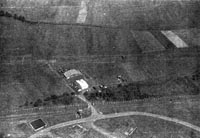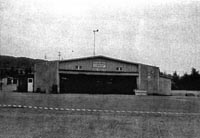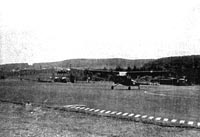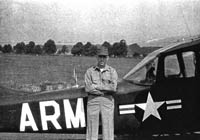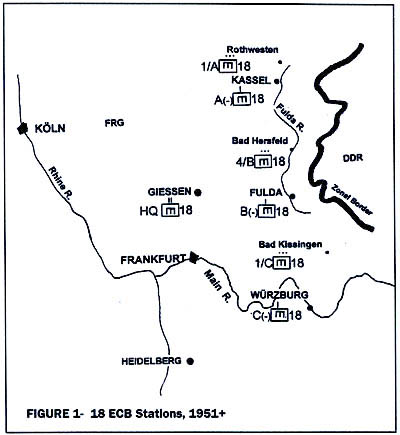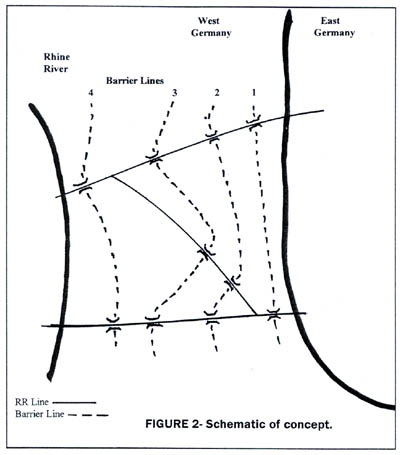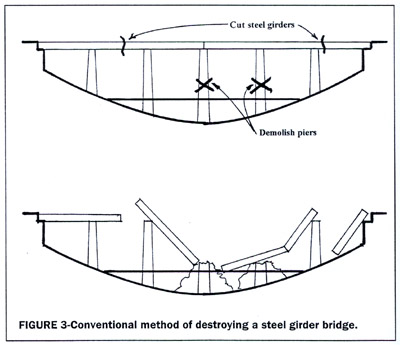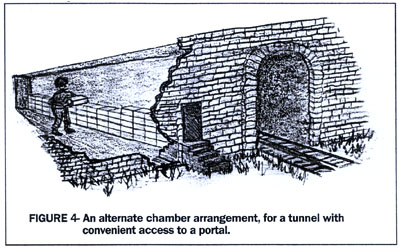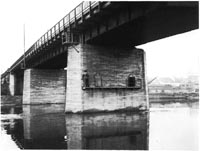| If you do
NOT see the Table of Contents frame to the left of this page, then
Click here to open 'USArmyGermany' frameset |
||||||||
|
18th
Engineer Battalion |
||||||||
|
|
||||||||
|
||||||||
|
|
||||||||
| 18th Engineer Battalion History | ||||||||
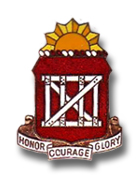 18th Engr Bn
(Cbt) DUI
18th Engr Bn
(Cbt) DUI |
||||||||
| If you have more information on the history or organization of the 18th Engr Bn, please contact me |
||||||||
| 1952 | ||||||||
| (Source: Email from Carroll Ludwick, Co A, 18th Engr Bn) | ||||||||
Back in 1952, I was at Rothwesten, Germany with 1st Platoon, Company A, 18th Combat Engineers. We were on an Air Force base there.
If I recall just one squad of us were there in order to be closer to our targets. The rest of the company was in Kassel, Germany. As you may know Kassel was only a few miles from Rothwesten. I did not take pictures back in those days and have lived to regret not doing so. But like so many I spent my free time at movies and drinking German beer. Just wanted to see if I could locate any of the guys who were there with me. After 50 years it will be hard to do. |
||||||||
| 1955 | ||||||||
| (Source: Email from George Currier, H&S Co and later C Co, 18th Engr Bn) | ||||||||
| I was stationed at Rivers Barracks in 1955-56 in H&S Company then was transferred to C Company in Wurzburg 1957. In Giessen I was assigned to the communication section and became radio sergeant in charge of the radio operators. Strictly CW, we operated two CW nets 24/7. One net was the Group Net, the other was a Battalion Net which connected each company and the two satellite platoons at the Fulda Gap and Bad Hersfeld. We used SCR 399’s for the CW nets – going on voice about once a month for practice. Each platoon was equipped with AN/GRC9s for the CW connections and for alert-field use. Each platoon leader in the line companies were provided the AN/GRC 9s. We had many ‘visits’ by Soviet embassy agents that would park on the narrow roadway that ran past Rivers Barracks to the town of Giessen taking notes. We were always a unit of interest to them. I was later assigned to Company C in Wurzburg as NCOIC of the radio section. We lost one man during a field exercise out of Wurzburg – Private Jackson, who was hit by a train on a double-track trellis bridge out of Wurzberg. The demolition people were loading explosives into the bridge caverns when a train passed and Jackson stepped across the double track – right into the pathway of a train going the other way – hidden by the other train. A tragic event for sure. I revisited Wurzburg and Giessen in the early 1990s and was surprised and disappointed how the areas have grown. ADDITIONAL INFORMATION |
||||||||
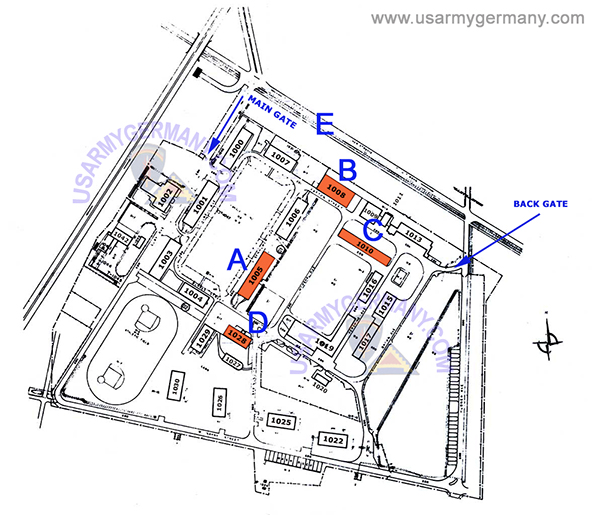 |
||||||||
| (A) was our barracks and offices. We used all floors including the attic, which we used for Commander’s Call. (B) 18th mess hall. (Incidentally, there was a 22 caliber range in its basement. Close quarters – lost some of my hearing there!) (C) was a shared building with the radio section’s radio (CW-Voice) radios set up. All of our trucks were inside and ready to go in minutes, 24/7. The out buildings that we used had been stables, with wooden block floors. The German 105th Calvary used them up until when they were sent to the Russian front 1940-41 (?). Our long wire antennas were located back there in the field. (D) represents where the Soldiers Club was. I believe that a couple of days a week that there was a one small room PX there. We would order cigarettes etc. and come pick them up . But I’m not certain about that recollection. (E) was the road to town. We shared the Kaserne with the 5th Engineers. As I recall, they were a traditional combat engineer battalion.. I believe that their entire battalion was at Rivers. There were two large murals depicting the 18th’s history. One in the 1st floor hallway near the battalion headquarter offices – which used the left side of the barracks (with the H&S Company on the right side, nearest the Soldiers Club.) The other mural was in the mess hall. It was of a map of the ALCAN highway – which the 18th was very instrumental in constructing 1942-1943 (?). The map pointed out the various areas that the 18th helped construct as well as the entire length of the roadway. I don’t recall that there was a theater on site. We didn’t have a relay site for our main net – however, Fulda gap and the other outlying platoon were only equipped with ANGRC-9s and they would sometimes have to relay through their base company to us at Giessen, as we were net control. The AN/GRC9’s were less than 50 watts I believe. The SCR 399’s that the main net used were 400 watts. Later we used German Siemens for the group net. I can’t recall the name of the barracks in Wurzburg – but I’m thinking that it was Larson (Kitzingen). |
||||||||
|
|
||||||||
| Aviation Section, 18th Engr Bn | ||||||||
| 1955 | ||||||||
| (Source: Information submitted by William J. Ennis and originally sent to Hanno Englaender) | ||||||||
| I was stationed
in Giessen, Germany from April 1955 to May 1957. I was assigned to
the 18th Engineer Battalion (C) at Rivers Barracks. My job assignment
was Aviation Officer. The Aviation Section
of the Battalion consisted of a pilot and five enlisted mechanics.
Our base of operations was at the Giessen Army Airfield which was
located on the north side of the Qartermaster Depot on Licher Strasse
towards the east side of Giessen. The airfield itself was approximately 1100 ft of pierced-steel-planking (PSP). We had an asphalt aircraft parking area. There were two hangars - one steel framed and one wooden. The wooden one was a hangar used by the German Air Force during WW2. Apparently the field was originally a bomber base. Our unit was in the wooden hangar and was shared by the 594th Artillery Battalion. They had two pilots and several enlisted mechanics. The hangar housed three Cessna L-19s. The steel hangar was used by the 5th Engineer Battalion (C) which had one pilot and three enlisted mechanics. Their aircraft was a Bell H-13 helicopter. There was a small sports airfield located northwest of the west end of our landing strip. They flew only gliders which were launched from a large ground winch. I watched them many times. The mission of the 18th Engineers was the demolition of all railroad bridges and tunnels in the north half of the American Zone of Occupation. This was to be done if the Russians crossed the border and after the 14th Armored Cavalry Regiment pulled out. It was estimated that our unit would sustain a 95% casualty rate. Our headquarters was at Giessen, but we had our line of companies at Kassel, Fulda and Wuerzburg with separate platoons at Kitzingen and Bad Kissingen. My job entailed flying staff personnel to these outlying units. The airfields at Kassel and Kitzingen were old Luftwaffe bases. The installation at Kitzingen was used by both the Army and the Air Force. I was only there a few times and do remember seeing the field used by C-123's. I also remember how wide the runway was and how undulating it was and how difficult it was to take off and land in a L-19. The ones at Bad Kissingen and Fulda were new. The landing strip we used at Wuerzburg was a 12 ft wide street in the middle of a housing project. I remember it very well as it usually took at least two passes to land because of the turbulence. Seeing that you (Hanno Englaender) live in Cologne reminds me of several flights I made there following the Lahn river from Giessen. Navigation was difficult as it was done at low level and by landmarks, railroads and roads. Our altitude was limited to 3000 ft above sea level. All airspace above 3000 ft was restricted and rigidly enforced. Many times flying over the Taunus Mountains at 2950 ft and being buzzed by an F-86 that was checking me out. It turns you every which way but loose. Once we used an old Me109 base which was on the west side of the Rhine and south of the Mosel. There were no buildings or facilities of any type. I remember it well as when my passenger, Major Cannon returned from his meeting, my battery was dead and I had to hand prop the L-19. It was no easy task. One other experience I had and enjoyed very much was a special flight we set up as a reward for the "soldier of the month". The flight left Giessen and followed the Autobahn south to Frankfurt picking up the Rhine near Ruedesheim. We would follow the Rhine north to Cologne and back to Giessen. I had obtained a pictorial pamphlet of all the castles and points of interest. At one time I knew all the names and pertinent facts of all the castles and towns. All that escapes me now but I do have the pamphlet in my scrapbook. I have flown to many other fields, such as Bamberg, Hanau, Wertheim, Stuttgart, Bad Kreuznach, Bad Nauheim and one on the west side of Frankfurt near the Autobahn. It was used by another Engineer Battalion in our Engineer Group. It was the 299th I believe. I also landed one time on the "marble runway" at Nuremburg where Hitler held his mayor rallies. It was a thrill. William J. Ennis |
||||||||
|
||||||||
|
|
||||||||
| Newspaper Articles | ||||||||
| (Source: The
Army Engineer, Sep-Oct 2002) Note: Some corrections will be made by the authors of the article in the next few days as the article, as originally published, contained some errors and omissions. |
||||||||
| The Destruction
Battalions Article written by COL Ray S. Hansen (USA, Ret.) and BG Robert M. Wilson (USA, Ret.) One of the earliest US additions to the newly-born NATO was the unusual 18th Engineer Combat Battalion. The Army created and fielded it almost overnight to help cope with its European forces' major strategic need of the day: buy time. For many years its records were classified, some very highly, but now the story can be told. Strategic Situation In August 1950 the fierce battles on the Korean peninsula were demanding the majority of the attention and resources of our limited post-WW2 armed forces. Communist North Korea's attack, with Soviet involvement, also raised broader strategic concerns. Could this be a feint for a Soviet onslaught upon Western Europe while the forces of the United Stares and others were tied down in Korea? Might nor the unstable Stalin, whether or not the USSR had instigated North Korea's attack, seize this opportunity for a massive assault across Europe? NATO allies were ill prepared to resist such an attack, if it came. Germany was still an occupied country, and had no armed forces. British, French and US units in Germany had been organized for occupation duties and not for defense against a former ally. The only major US units were the 1st Infantry Division, the US Constabulary, and the 6th Infantry Regiment in Berlin. The Constabulary was a light three-brigade force designed for reconnaissance and overseeing boundaries. Engineer field units were the 1st Engineer Battalion of the 1st Infantry Division, and the 54th and 547th Engineer Combat Battalions. These, and similarly small British and French forces, desperately needed augmentation to defend against, even slow down, an assault. The still powerful Red Army had kept 20-plus divisions in East Germany, with ten more behind those and a total force of two and a half million. The situation was urgent, but reinforcements would take time. It was essential to establish a credible defense plan from existing forces. A defense at the border could not be expected to succeed, but a fighting delay while withdrawing to rearward defensive positions might gain enough time for reinforcements to arrive. lt was imperative that the Soviets not be allowed to cross the Rhine River. It was known that the Soviets relied heavily on rail for logistics and heavy equipment. Massive interdiction of West Germany's east-west rail system would be required to impede movement of bridging equipment for Soviet crossings of major rivers such as the Main and the Rhine. For this vital mission, the Pentagon ordered two units specially created and deployed. The first, the 18th Engineer Combat Battalion, was organized from scratch in West Germany in August 1950. The authors of this article were members of the 18th from its activation to 1953. While we are writing primarily about our own unit much of the information herein also applies to the second (and similar) unit, the 485th Engineer Combat Battalion. The 485th was called to active service from the Army Reserve a month later, in September. It was reorganized at Fort Belvoir, VA, and arrived in Germany February 1951. Organization The Army activated the 18th on 15 August 1950 at Fliegerhorst Kaseme in Kaufbeuren, Germany. It was attached to the 555th Engineer Combat Group, which gave it this order. "Your mission is to train your battalion so that it is prepared to participate in sustained combat operations. Emphasis will be placed on demolitions and bridging, with priority to the former." The starting point for the organization was the standard army-level engineer combat battalion. To adapt it to its mission, major increases were made in personnel strength, transport, and communications. Line companies received a fourth platoon. Motor transport was almost doubled. Squads were given two 2½-ton dump trucks with cargo trailers and a jeep with trailer. Platoon headquarters had a 2½-ton truck and trailer, a ¾-ton truck, and a jeep with trailer. Overall, the battalion had 212 vehicles. Powerful communications equipment was added, for the battalion would be widely dispersed. Battalion headquarters and companies were equipped with the SCR 399, a long-range CW (Morse Code) radio, van-mounted on a 2½-ton truck. Companies and platoons communicated with the ¾-ton truck-mounted SCR 193 (also CW, for long-range reliability). Platoon leaders and squads had the AN/VRC-2, a jeep-mounted voice set similar to those used by Military Police. A fixed-wing aviation section augmented communications and control. Heavy equipment and its operators were omitted, except for truck-mounted air compressors. Squads and platoons retained their pioneer, carpenter, and of course demolition sets. Stationing Before dawn one snowy day in early February 1951, the 18th formed its convoys and moved to the permanent stations shown in Figure 1, centered on the "Fulda Gap." Battalion headquarters went to Giessen, A Company to Kassel, B Company to Fulda, and C Company to Würzburg. |
||||||||
|
||||||||
| Barrier
Planning The 555th Engineer Combat Group prepared the Strategic Railway Denial Plan and assigned missions to the two battalions. In December 1950, ground and air teams from the group and battalion staffs began reconnaissance to identify bridges and tunnels that could meet the strategic criteria. Upon deployment, the battalion headquarters made target assignments to companies, and they were further allocated to specific platoons and squads. Platoon leaders and NCOs immediately became familiar with their targets, routes, and other bridges and tunnels in their areas. |
||||||||
|
||||||||
| Demolition
Methods For most targeted bridges, getting a 200 foot gap meant taking out at least two piers and making steel cuts in two places. Figure 3 shows what had to be done on a typical steel girder bridge. NOTE: Figure 3 is incorrectly captioned. The "conventional" method of blowing a bridge is to drop one span, for that is enough to delay the enemy's vehicles. Also, we may have to repair it later ourselves. For the railway denial mission, it was necessary to carry out much more extensive demolition, as portrayed in the sketch, to cause a protracted delay in enemy rail movements. |
||||||||
|
||||||||
| Explosives
The quantity of explosives in basic loads approached 100 tons per company, like a Class V depot on wheels. We used three kinds of explosives. The bulk of it was tetrytol ("M-1 demolition Block"). It came in satchels of eight 2½ pound blocks strung on a line of detonating cord running down the center of each block. For cutting steel, basic loads included Composition C-3 ("plastic"), in 2½ pound blocks, 16 to a box. We also had considerable quantities of TNT for training. Explosives were kept combat loaded on vehicles at all times. Before loading the tetrytol, we rook the satchels out of the wooden boxes they were was packed in, and threw the boxes away. We were authorized to overload vehicles. One 2½-ton truck in each squad was loaded to 4 tons. Each squad's two cargo trailers carried 1½ tons, bringing the total for each squad to 7 tons. Blasting caps were carried in jeep trailer. This degree of delegation would blow the mind of an over-management, over-control type of boss! Most squads could transport sufficient explosives for all of their targets. But additional demolition resupply points were available at Wetzlar, Hanau, and Münster. Explosives-loaded trucks, about half of all vehicles, were parked at an off-post site, in a row of open sheds out in the middle of a nearby agricultural field. It was a do-it-yourself operation, no MP's nor high-tech surveillance gear. To provide for unit continuity, as well as training in leadership and discipline, guard duty was rotated one squad at a time and one week at a time. Security fencing was ordinary tactical barbed wire. Later, explosive storage areas were upgraded to include commercial fencing and riveted parking stalls. One company commander remembers his security concerns as something between constant headache and recurring nightmare. Staying Ready In addition to the periodic 7th Army alerts, the battalion, companies and platoons conducted their own exercises. Occasionally an entire mission would be practiced, unannounced. A unit would go to each assigned target in succession, simulate its destruction, and proceed along the prescribed route all the way to its designated assembly area near the Rhine. These comprehensive exercises were at platoon or squad level, to minimize readiness impact. On 17 March 1951, 7th Army issued an order prohibiting practice on actual assigned targets. Neither real nor dummy explosives were to be placed, even under cover of maneuvers. Targets could be measured or sketched only by small parties under cover of maneuvers. The purpose was to enhance security and avoid public alarm. This restriction seriously impacted the squads' ability to prepare for their missions. Some targets, which during early reconnaissance had seemed easy, were actually proving extremely difficult to load. The Battalion S-3 at the time, Major (later Colonel) Robert P. Graves, recently wrote: "...one squad was going to load little boats, paddle out to the pier, then string cable, etc. But they would not have been able to control those little boats in the current -- never reach the pier. One squad had to load a RR tunnel with 8000 pounds. To get there, they would have to climb a steep face, walk a couple of hundred yards. Well, there was no way they could do this in the time allowed. We also found that some chambers in piers were way too small for charges. JD [the battalion commander, Lieutenant Colonel (later Colonel) Jesse D. Kelsay] and I violated those roles, to get them blown in time. Live explosives, however, were never loaded. With practice, each squad developed ingenious methods that they knew would really work. To our knowledge the battalion never had a serious explosive incident, despite years of bouncing those huge loads over the then mostly cobblestone roads. Explosive materials proved exceptionally stable. But there were some scary moments. A former squad leader describes one of them: "...we were in convoy going through Gelnhausen and trying to maneuver through those narrow streets when we lost sight of the other trucks. Well the driver speeded up and we were zipping along pretty good until we rounded a curve and found the convoy had stopped and smacked right into the trailer loaded with explosives. There was tetrytol all over the place. We cleaned the place up and managed to get the trailer going again and made it back to Fulda." Individual training continued too. There was a requirement to have two trained demolition specialists in every squad. But everybody participated in the training: computing charge sizes, assembling ring-mains, and placing and detonating charges both dummy and real. Other mission-essential subjects included map reading, convoy discipline, vehicle maintenance, communications procedures, and small unit defense. Everyone was trained on bridging, especially the Bailey Bridge and steel treadway floating bridges. Most training was decentralized to platoons, putting a heavy load on platoon and squad leaders but paying dividends in small unit team-building and developing leadership skills. Conclusion The story of the 18th offers several examples of organizations and individuals stepping up to extraordinary challenges in unique circumstances: An Army doing what it can with what it has, despite tremendous odds. Within months, transforming a strategic concept into forces on line, equipped and trained. Key role of the Engineer Group HQ in planning, support and leadership. Round the clock communications watch, continuously for years, from Army Headquarters dowb to company and separate platoon level. Complete absence of security incidents or accidents involving explosives, despite frequent handling and transport. Extreme decentralization of operations, reliance upon squad teams for critical action. Epilogue As US and NATO troop strength grew, problems developed with the concept of an essentially separate unit on a separate mission. Some targeted bridges were needed by tactical units, requiring close coordination with affected tactical commanders. It became necessary to obtain clearance for use of certain roads. Demolitions had to be coordinated with non-combatant evacuation plans. Over time, the distinction between strategic demolition of the rail system and conventional tactical demolitions became blurred. By 1957, NATO had become an impressive, functioning alliance. The US had four additional divisions in West Germany, with armored cavalry regiments deployed along the border with East Germany. Allied forces had been similarly reinforced. A new German army had been organized. The US 7th Army had a full complement of engineer units that could take on demolition missions. It was now possible to conduct an effective defense well east of the Rhine. Immediate destruction of the rail system at outbreak of conflict was no longer a strategic need. The 485th was released from active service in 1955. On 7 June 1957, the 18th Engineer Combat Battalion, the first and last of the Destruction Battalions, also retired its colors. ADDENDUM: When 485th was released from active service, concurrently, the battalion was re-designated the 237th Engineer Battalion, by a flag change in place. The 237th had the same organization, equipment and mission as the 485th. We believe, though we are not sure, that at about the same time that the 18th Engineer Battalion was inactivated in 1957, the 237th was re-organized as a conventional Army-level engineer combat battalion. The 237th remained in Germany, part of the 7th Engineer Brigade of VII Corps. CORRECTION In the section on Organization, some of the vehicle descriptions were garbled. The explosives-carrying vehicles in the squads were 2 ½ ton trucks with 1 ton trailers. The company and platoon communications vehicles were a 2 ½ ton truck and a ¾ ton truck, respectively. Figure 3 is wrongly captioned. The “conventional” method of blowing a bridge is to drop one span, for that is enough to delay the enemy’s vehicles. Also, we may have to repair it later ourselves. For the railway denial mission, it was necessary to carry out much more extensive demolition, as portrayed in the sketch, to cause a protracted delay in enemy rail movements. Near the end of the article is the sentence, “The 485th was released from active service in 1955.” While that is correct, the battalion was re-designated the 237th Engineer Battalion, by a flag change in place. The 237th had the same organization, equipment and mission as the 485th. We believe, though we are not sure, that at about the same time that the 18th Engineer Battalion was inactivated in 1957, the 237th was re-organized as a conventional Army-level engineer combat battalion. The 237th remained in Germany, part of the 7th Engineer Brigade of VII Corps. The photograph below shows actual demolition chambers, in a railroad bridge over the Main River near Aschaffenburg. |
||||||||
|
|
||||||||
|
||||||||
|
|
||||||||
| The above article
has been posted with the permission of the AEA. Anbody
interested in knowing more about the AEA may contact them at - Army Engineer Association P.O. Box 30260 Alexandria, VA 22310-8260 COL J. B. O'Neill, USA (Ret), Executive Director PHONE: (703) 428-6049 EMAIL: xd@armyengineer.com WEBSITE: www.armyengineer.com |
||||||||
|
|
||||||||
|
Related Links: |
||||||||

